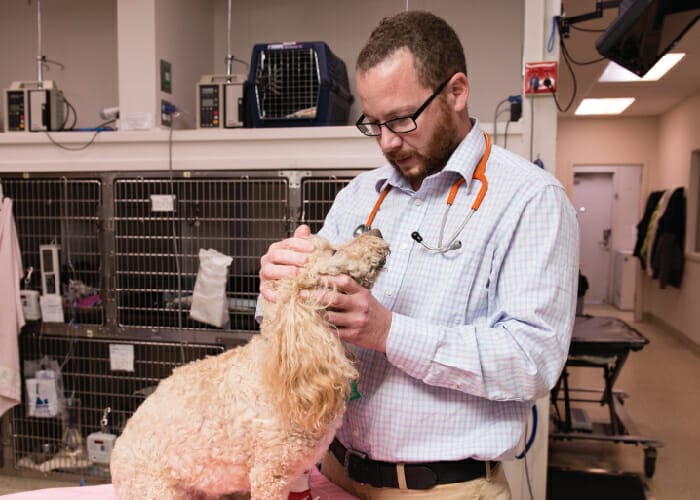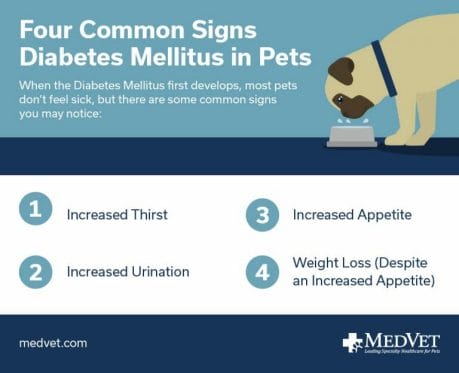
Did you know that diabetes mellitus is a common cause of increased thirst and urination as well as weight loss in dogs and cats? Initial signs are often attributed to changes in weather or routine. But over time, the changes become very pronounced, and the pet needs to be evaluated by a veterinarian.
Many of us are familiar with diabetes mellitus as a condition in people and are familiar with the idea of insulin therapy, but not many realize that diabetes management in dogs and cats varies greatly from diabetes management in people.
What is Diabetes Mellitus?
Simply put, diabetes mellitus (DM) is caused by the failure of the pancreas (an organ in the belly near the stomach) to regulate blood glucose (sugar) levels. In general, DM in dogs is similar to Type I DM in people where the dog will require insulin therapy lifelong. Conversely, DM in cats is similar to Type II DM where the cat may not require lifelong insulin therapy and instead may be able to be managed with dramatic changes in diet and lifestyle.
What are the Signs of Diabetes Mellitus in Dogs and Cats?
The four common signs of uncomplicated DM are:
1. Increased thirst
2. Increased urination
3. Increased appetite
4. Weight loss (despite an increased appetite)
Insulin is a very important hormone that allows the cells within the body to absorb and use glucose (sugar) for energy. If there is not enough insulin present in the body, the cells cannot use the glucose and the glucose level in the blood continues to increase. This is called hyperglycemia. During hyperglycemia, the kidneys (important organs for filtering nutrients including glucose) become overwhelmed and cause glucose to spill over into the urine. This results in increased urine production which is a common symptom in dogs.
As a result of the pet urinating so frequently, the body compensates for this water loss by causing an increase in thirst to prevent dehydration. Weight loss commonly occurs despite an increased appetite because the body can’t use glucose effectively and instead uses protein and fat. As less glucose is available to the body for energy, there is more break down of fat and protein resulting in dramatic decreases in weight and muscle mass.

Diagnosing Diabetes Mellitus in Dogs and Cats
Dogs and cats are often diagnosed with DM when taken to the vet for increased thirst, urination, and weight loss despite a hearty appetite. Your veterinarian will perform lab work which will reveal an increase in your pet’s blood glucose as well as glucose within your pet’s urine. Sometimes further testing is performed such as a fructosamine level which is a specific blood test that measures the average blood glucose level over a two-to-three-week period.
It is important to note that other conditions can cause hyperglycemia such as stress (often in cats) and glucose in the urine not caused by DM (such as injury to the kidneys). Therefore, your veterinarian will often run a full blood and urine panel to ensure DM is the cause of your pet’s clinical signs and not another condition.
Often pets with undiagnosed DM will have a urinary tract infection (UTI) because the extra glucose in the urine is a perfect environment for bacteria to grow. Your veterinarian may order a urine culture, or your pet may get antibiotics to treat for a UTI. Specific recommendations for your pet will be discussed after learning about your pet’s medical history, performing a full physical exam, and interpreting initial lab work results.
Treating Diabetes Mellitus
If your cat is diagnosed with DM, your veterinarian may start them on injectable insulin and will recommend a specific diet. Diets higher in protein but lower in carbohydrates have the goal of maintaining a healthier and more even blood glucose level throughout the day. This helps avoid peaks and valleys in blood sugar levels that can make controlling DM difficult.
For dogs diagnosed with DM, your veterinarian will start them on injectable insulin and a diet change may be recommended depending on your dog’s individual needs. One of the number one goals of managing diabetic dogs is consistency. This means a consistent diet, consistent mealtimes, consistent insulin injection timing, and consistent exercise.
Often only one type of insulin is used to manage your pet’s diabetes. Your veterinarian will help educate you on the best insulin type and diet recommendation for your individual pet. A diagnosis of DM and insulin injections may sound daunting, but don’t worry, with a consistent routine and consistent praise, you and your pet can continue to have a great quality of life together!
Monitoring Diabetic Dogs and Cats
Just like in people, DM monitoring varies and recommendations will be specific for your pet. Your veterinarian may recommend glucose curves to be performed at home or in the veterinary clinic, monitoring urine with test strips, or by using a continuous glucose monitor (CGM), a newer and often easier way to monitor diabetic pets. A continuous glucose monitor uses a sensor placed on your pet’s skin with a small probe that measures their glucose level continuously, 24/7, for 14 days. This continuous monitoring system provides your veterinarian many reports, graphs, and logs depicting how your pet is responding to their insulin every hour of every day. As with most things, monitoring tools are not one size fits all, so your veterinarian will discuss the best option for you and your pet.
Regardless of the monitoring method chosen for your pet, the goals of diabetic control are the same:
- Ensure your pet’s thirst and urination habits have improved (ideally close to your pet’s normal).
- Ensure your pet maintains a healthy weight.
- Preserve the strong human-animal bond shared between you and your pet.
Keep in mind that your dog or cat’s insulin dose should not be adjusted without the guidance of a veterinarian. Dramatic changes in insulin dose can cause detrimental effects to your pet’s health.
Work with Your Veterinarian
Just remember, if your pet has been diagnosed with DM, don’t worry; the veterinary community is here to help. We will encourage your participation in your pet’s diabetic control and support you as you aim to always provide the best quality of life for you and your pet! Learn more about internal medicine at MedVet and the team that can support your pet.